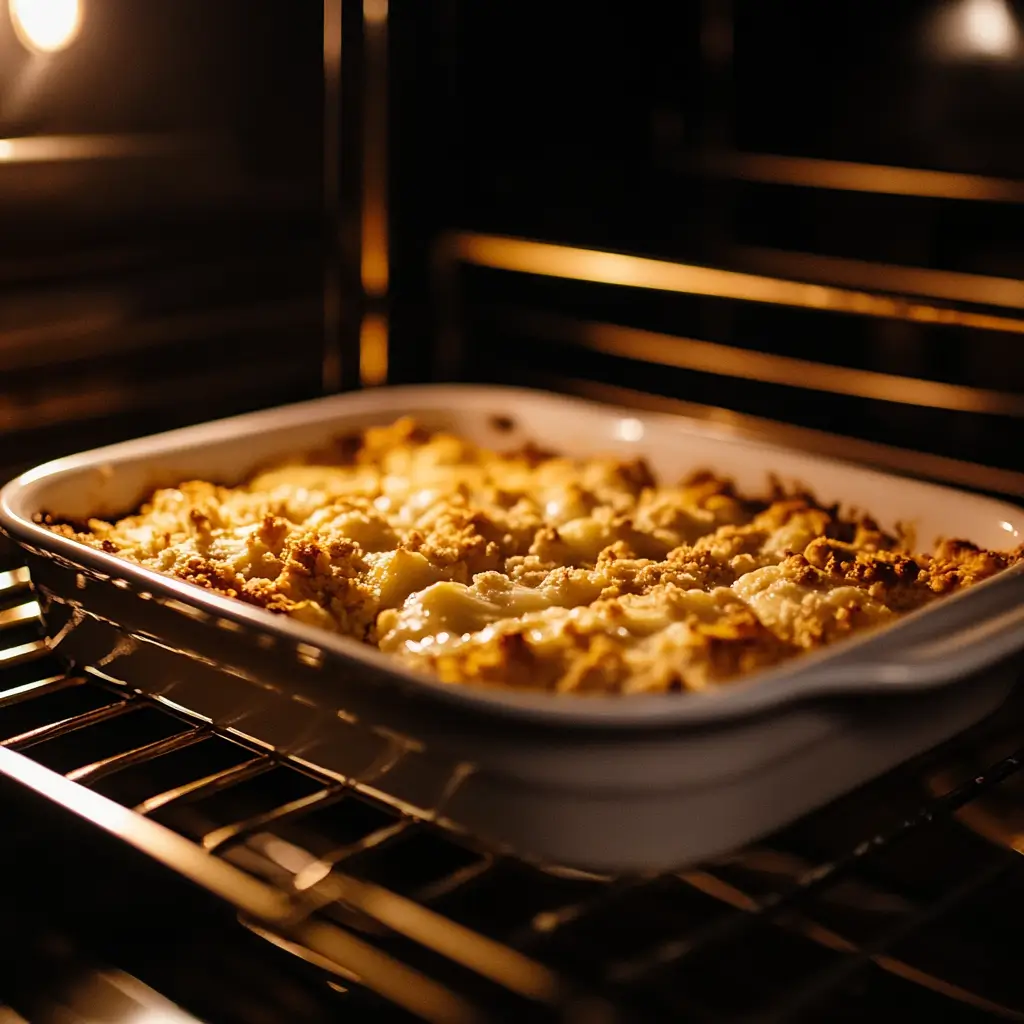Fruit-filled desserts are among the most comforting and satisfying treats, but few spark as much confusion as dump cake vs cobbler. At first glance, they seem quite similar—both involve baked fruit with a golden, textured topping. However, their preparation, ingredients, and textures differ significantly.
If you’ve ever wondered whether dump cake is the same as cobbler, you’re not alone! Many home bakers struggle to distinguish between the two, especially since both can be made quickly and require minimal baking skills.
In this detailed guide, we’ll explore:
Table of Contents
By the end, you’ll know exactly which dessert suits your taste and baking style. Whether you prefer the gooey, buttery simplicity of a dump cake or the soft, biscuit-like texture of a cobbler, this guide will help you master both!
What is a Dump Cake?
Origins & History
Unlike traditional cakes, dump cakes require no mixing or creaming of ingredients. Instead, they became popular in the 1960s, thanks to the rise of pre-packaged cake mixes. These easy-to-make desserts were heavily featured in church cookbooks, homemaker magazines, and television ads, making them a household staple.
The name comes from its effortless preparation—you simply “dump” the ingredients into a baking dish, layer them, and bake. Because of this, dump cakes quickly became a favorite among busy home cooks and beginner bakers.
Today, variations of dump cake include:
Chocolate and cherry dump cake (chocolate cake mix + cherry pie filling)
Pumpkin dump cake (spiced cake mix + canned pumpkin)
Apple cinnamon dump cake (yellow cake mix + apple pie filling + cinnamon)
Ingredients & Texture
A classic dump cake requires only three ingredients:
- Canned fruit or pie filling (such as peaches, cherries, or pineapple)
- Boxed cake mix (typically yellow, vanilla, or spice cake mix)
- Butter (sliced or melted)
Unlike a traditional cake, the cake mix remains dry when added to the dish, absorbing moisture as it bakes. The result? A crispy, buttery top layer with a soft, fruit-filled bottom. The contrast of textures is what makes dump cake unique—it’s not quite a cake, not quite a crisp, and not quite a cobbler!
Why Dump Cakes Are Popular
- No mixing or beating required—perfect for beginners.
- Ready in under an hour, making it an excellent last-minute dessert.
- Easily customizable—swap out fruits, cake mixes, and toppings.
- Minimal cleanup—fewer dishes, no bowls needed!

What is a Cobbler?
Historical Background
Unlike dump cakes, which have modern origins, cobblers date back centuries. Early European settlers in colonial America lacked the proper ingredients to bake traditional European-style pies, so they improvised.
Instead of a classic pie crust, they covered fresh fruit with a rough, biscuit-like dough or batter and baked it in cast-iron skillets. This rustic, adaptable dessert became a staple in the American South, with variations emerging in different regions.
Popular cobbler styles include:
Southern cobbler – Topped with a soft, biscuit-like dough.
Western cobbler – Uses a thinner, cake-like batter.
Deep-dish cobbler – More similar to a pie but without a bottom crust.
Today, cobbler remains a beloved classic, often served warm with vanilla ice cream for the ultimate comfort food experience.
Traditional Ingredients & Variations
Cobblers are typically made with:
- Fresh or canned fruit (peaches, blackberries, apples, cherries)
- Flour, sugar, and baking powder (for the biscuit topping)
- Butter and milk (to create a rich, golden topping)
The topping differs based on region and preference:
Some use drop biscuits, creating a chewy, doughy texture.
Others use a cake-like batter, resulting in a spongier consistency.
Some cobblers have a rolled dough layer, giving it a crust-like quality.
Texture & Flavor
Cobblers have a thicker, more substantial topping than dump cakes. The texture depends on whether the topping is:
- Biscuit-style – Crispy, crumbly, and slightly dense.
- Cake-style – Soft, fluffy, and more uniform.
Regardless of the topping, cobblers have a juicy, syrupy fruit base that thickens as it bakes. This balances the richness of the biscuit topping, making each bite a perfect blend of textures.
Dump Cake vs. Cobbler: Key Differences
Is Dump Cake the Same as Cobbler?
No. While both desserts feature baked fruit with a top layer, the main difference is in how they’re prepared:
- Dump cake uses cake mix and butter to form a crisp, golden topping.
- Cobbler uses homemade biscuit dough or cake batter for a soft, baked crust.
Is Cobbler Just a Crumble?
No. Crumbles are similar to crisps, featuring a streusel-like topping made from butter, sugar, and oats. Cobblers, on the other hand, have a structured dough topping.
Is Cobbler a Cake or Pie?
Neither! Cobbler falls into a unique dessert category—it has a thicker, heartier topping than pie, but it’s not fluffy like a traditional cake.
What’s the Difference Between Cobbler and Crisp?
The main difference is the topping:
Cobbler – Uses biscuit dough or cake batter.
Crisp – Has a crunchy oat-based topping, often with brown sugar.
Both desserts are delicious, but if you prefer a more textured, crunchy topping, go for a crisp. If you love a soft, buttery topping, cobbler is the way to go!
Ingredients & Instructions for Both Desserts
Dump Cake Recipe
| Ingredient | Amount | Notes |
|---|---|---|
| Canned Fruit (Peach, Cherry, etc.) | 1 can | Can substitute with fresh fruit |
| Yellow Cake Mix | 1 box | Vanilla or spice mix works too |
| Butter (Melted) | ½ cup | Unsalted works best |
Instructions:
1️⃣ Preheat oven to 350°F (175°C).
2️⃣ Pour canned fruit into a baking dish.
3️⃣ Sprinkle the dry cake mix evenly over the fruit.
4️⃣ Drizzle melted butter on top.
5️⃣ Bake for 40-45 minutes until golden brown.
How to Perfect a Dump Cake Every Time
Dump cakes are known for their simplicity, but small tweaks can elevate them from good to incredible. Follow these detailed steps and pro tips for the perfect texture and flavor.
1️⃣ Prepare the Baking Dish for Even Baking
- Preheat your oven to 350°F (175°C).
- Lightly grease a 9×13-inch baking dish to prevent sticking.
- If using glass or ceramic, reduce the temperature by 10-15°F to avoid over-browning.
2️⃣ Select and Prep Your Fruit Filling
- Use canned fruit, fresh fruit, or pie filling based on your preference.
- If using fresh fruit, mix it with:
- ½ cup sugar (adjust to taste).
- 1 tablespoon cornstarch (to thicken the juices).
- ½ teaspoon cinnamon or nutmeg for warmth.
⏩ Pro Tip: For extra depth of flavor, roast fresh fruit with 1 tablespoon of honey before layering.
3️⃣ Distribute the Cake Mix Properly
- Sprinkle dry cake mix evenly over the fruit layer.
- Avoid stirring! The cake mix should sit directly on top for a crispy crust.
4️⃣ Add Butter the Right Way
- Use thin slices of cold butter instead of melted butter.
- Space the butter slices evenly to ensure uniform browning.
- Alternatively, mix ½ cup of melted butter with ¼ cup of milk for a richer topping.
5️⃣ Bake to Perfection
- Bake for 40-45 minutes, or until the top is golden brown and crispy.
- Let the cake cool for 10 minutes to allow the fruit to set.
⏩ Pro Tip: For an extra crunchy topping, sprinkle ¼ cup chopped pecans or crushed graham crackers over the cake mix before baking.
How to Make the Perfect Cobbler Every Time
A cobbler requires a few more steps than a dump cake, but the results are worth the effort. Follow these detailed instructions to create a fluffy, buttery topping with a rich fruit base.
1️⃣ Prepare the Fruit Base for Maximum Flavor
- Use fresh, frozen, or canned fruit depending on availability.
- If using fresh fruit, toss it with:
- ½ cup sugar to enhance sweetness.
- 1 tablespoon lemon juice to balance acidity.
- 1 tablespoon cornstarch for thickening.
2️⃣ Create the Perfect Biscuit Topping
- In a mixing bowl, whisk together:
- 1 cup flour
- ½ cup sugar
- 1 teaspoon baking powder
- ¼ teaspoon salt
- Cut in ¼ cup cold butter until the mixture resembles coarse crumbs.
- Stir in ½ cup milk or buttermilk to form a soft dough.
3️⃣ Assemble and Bake the Cobbler
- Spread the fruit mixture evenly in the baking dish.
- Drop spoonfuls of cobbler dough over the fruit.
- Bake at 375°F (190°C) for 40-45 minutes, until the topping is golden brown.
⏩ Pro Tip: For a crunchy finish, brush the dough with heavy cream and sprinkle with coarse sugar before baking.
Expert Tips & Creative Variations
🔹 How to Prevent a Soggy Bottom
- For dump cakes, drain canned fruit before layering to reduce excess moisture.
- For cobblers, sprinkle 1 tablespoon of flour over the fruit before adding the topping.
🔹 Make It Extra Crispy
- For dump cake, add crushed graham crackers to the cake mix.
- For cobblers, increase the oven temperature to 400°F (205°C) for the last 5 minutes of baking.
🔹 Healthier Alternatives
- Use coconut sugar instead of white sugar for a lower glycemic option.
- Swap butter for Greek yogurt in cobbler dough for a lighter version.
FAQs
Is a dump cake the same as a cobbler?
No! While both involve baked fruit with a top layer, the key difference is in texture and preparation:
Dump cake uses dry cake mix and butter for a crisp, crumbly topping.
Cobbler features a homemade dough or biscuit topping for a soft, golden crust.
Is cobbler just a crumble?
No. Crumble has a streusel topping made with oats, butter, and sugar, while cobblers use a biscuit-like dough or batter.
Is cobbler a cake or pie?
Neither! Cobbler falls into a unique dessert category. It lacks a bottom crust like a pie and doesn’t have the uniform sponge texture of a cake.
What’s the difference between cobbler and crisp?
The topping is the key difference:
✔️ Cobbler – Uses a soft, biscuit-like topping.
✔️ Crisp – Features a crunchy oat-based topping.
Can I use fresh fruit for dump cake?
Yes! However, you should add sugar and cornstarch to balance the sweetness and thicken the juices.
Why is my cobbler topping doughy?
If your cobbler topping is doughy, it might be undercooked. Try baking for an additional 5-10 minutes until golden brown.
How do I store leftovers?
Dump cake: Store in the fridge for up to 3 days. Reheat in the oven at 350°F for 10 minutes.
Cobbler: Store at room temperature for 1 day or refrigerate for up to 4 days.
Can I freeze dump cake or cobbler?
Yes!
Dump cake can be frozen for up to 3 months.
Cobbler should be frozen before baking for best results.
Conclusion
Both dump cakes and cobblers are delicious, easy-to-make desserts with unique characteristics:
✔️ Dump cake is fast, effortless, and has a crispy, buttery topping.
✔️ Cobbler is fluffier, richer, and has a traditional homemade taste.
If you need a quick, no-mess dessert, go for a dump cake. If you prefer a heartier, homemade treat, a cobbler is your best choice. Either way, you’ll end up with a comforting, fruit-filled dessert that’s sure to impress! 🎉
